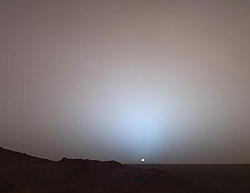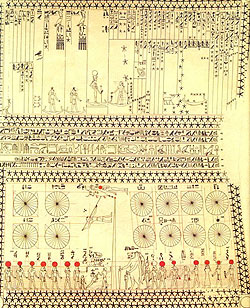National Aeronautics and Space Administration
Goddard Space Flight Center

Sun-Earth Day 2009: Our Sun Yours to Discover
Issue #64: The Sun, Our Nearest Star

The sun from another planet! On May 19, 2005, Mars Exploration Rover Spirit captured this stunning view as the sun sank below the rim of the Gusev crater on Mars. (Courtesy - NASA /JPL / Texas A&M / Cornell)
For millennia, humans considered the sun and the stars to be very different, but modern science proves they are fundamentally the same. The fact that the sun is a star is one of those facts that defies intuition. We see stars only by night, and the sun only by day. The sun is a billion times brighter than the brightest star, and warms our faces in a way that cold starlight never can.
Most ancient civilizations distinguished between the sun and stars in their temple and tomb drawings, or the precious few writings that have survived. The ancient Egyptians represented the sun by one of its chief gods, Ra (or Re), while the stars were not accorded any particular respect other than to form the boundaries of occasional constellations that formed their many divinities. For instance, the constellation we recognize as Orion was their god Osiris. The goddess of wisdom, writing, and knowledge known as Seshat is associated with stars and the night sky. Dressed in a spotted leopard skin, the spots were taken as a symbol for the stars or eternity. She was eventually replaced by Thoth in later dynasties, as the Cult of the Moon gained popular and political ascendancy over Egypt.
According to what we know about historical writings that have survived, the first persons to suggest the Sun is nearby star (themselves thought of as distant burning rocks) was Anaxagoras, around 450 BC, and Aristarchus of Samos, around 220 BC. Aristarchus actually worked out that the sun was much bigger than earth, and that earth orbited this enormous body - not the other way around! About 1800 years later, Giordano Bruno (1590) also made this suggestion, and was burned at the stake for daring to suggest it in the face of the prevailing religious beliefs.
By the time of the Dutch astronomer Christian Huygens (1629-1695) the distance to the bright star Sirius had been worked out by assuming it was actually as bright as the sun. By the 17th century, the idea that the sun was a star had been pretty well accepted by scientists. This hypothesis was actually proved by the German mathematician Friedrich Bessel (1784-1846) in 1838, who used parallax methods to determine the geometric distances to nearby stars such as 61 Cygni (11 light years). A star's apparent brightness in the night sky could then be converted into a true brightness (how many watts of light it emits), which for many stars turned out to be similar to the sun. Soon, the temperatures, masses and chemical compositions of stars were determined in the late-1800s, and also found to be similar to the sun, proving the original sun-as-star hypothesis once and for all.

Part of the Senenmut star map ca 1500 BC (Courtesy: Metropolitan Museum of Art)
The Sun-Earth Connection
The realization that our sun is a star allowed many comparisons to be performed between the properties and evolution of distant stars, and our own sun. This accelerated our understanding of the past, present and future of our sun and its impact upon the solar system...and Earth.
Space Math Connection:
These problems are available at Space Math @ NASA (http://spacemath.gsfc.nasa.gov)
Predicting the Next Sunspot Cycle [Problem 100]. Students examine a plot of the sunspot cycle and extract information from the plotted data about the previous sunspot cycle. They use this to make predictions about the next sunspot cycle about to start in 2008. [Skills: graph reading; extrapolation; time calculations]
Monster Sunspots! [Problem 107]. Some sunspots are so big they can be seen from Earth without a telescope. In this problem, students will use images of three super-spots and calculate their sizes from the image scaling information. They will then order the images from the smallest to the largest super-spot. [Skills: Multiplication; calculating length from image scale]
The Parallax Effect [Problem 118]. The STEREO mission views the sun from two different locations in space. By combining this data, the parallax effect can be used to determine how far above the solar surface various active regions are located. Students use the Pythagorean Theorem, a bit of geometry, and some actual STEREO data to estimate the height of Active Region AR-978. (Skills: Pythagorean Theorem; square-root; solving for variables).
A Model of the Sun's Interior [Problem 115]. Students will use the formula for a sphere and a shell to calculate the mass of the sun for various choices of its density. The goal is to reproduce the measured mass and radius of the sun by a careful selection of its density in a core region and a shell region. Students will manipulate the values for density and shell size to achieve the correct total mass. This can be done by hand, or by programming an Excel spreadsheet. (Skills: Scientific notation; volume of a sphere and a spherical shell; density, mass and volume.)
References:
SED-2007 - Solar Science:
- TTT 48 - The Sun from Cradle to Grave
- TTT 49 - Solar Energy
- TTT 50 - Ancient Sunlight
- TTT 52/6 - Solar activity and features
- TTT 57 - The Heliosphere
SED-2008 - Space Weather Around the World:
- TTT 58 - Why is the sun's corona hot?
- TTT 59 - Where did all the neutrinos go?
- TTT 60 - Where does the sun's magnetic field come from?
Dorman, P. F., The Tombs of Senenmut. The Architecture and Decoration of Tombs 71 and 353., Metropolitan Museum of Art Egyptian Expedition, New York 1991
Credits:
Dr. Sten Odenwald (Author - Hinode)
2009 ISSUES
View past issues
NASA Fact
The August 4, 1972 solar flare was so powerful that, by some estimates, a spacesuited astronaut would have received a lethal does of radiation.
